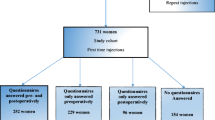Abstract
Urethral injection is a convenient, minimally invasive means of treating stress urinary incontinence (SUI). We present long-term follow-up data from 20 patients originally recruited in 1994–95 (mean age 67 years) to receive urethral injection with dextranomer/hyaluronic acid (Dx/HA) copolymer. The majority of patients had failed previous therapy for SUI. If the first injection was unsuccessful, up to two further injections were offered. Only 3 patients (15%) failed to show a response to treatment. Sixteen women were reassessed during 2001 (4 had died of causes unrelated to the study treatment). A sustained response throughout the follow-up period was reported in 9/16 patients (57%), with incontinence recurring in just 4 (25%). None of the 7 patients with persistent or recurrent incontinence were cured by subsequent treatments, including surgery. In conclusion, urethral injection with Dx/HA copolymer offers promising long-term efficacy in the treatment of SUI, regardless of old age or failure to respond to previous therapy.

Similar content being viewed by others
Abbreviations
- SUI:
-
Stress urinary incontinence
- VUR:
-
Vesicoureteral reflux
References
Bent AE, Foote J, Siegel S et al. (2001) Collagen implant for treating stress urinary incontinence in women with urethral hypermobility. J Urol 166:1354–1357
Herschorn S, Glazer AA (2000) Early experience with small volume periurethral polytetrafluoroethylene for female stress urinary incontinence. J Urol 163:1838–1842
Leach GE, Dmochowski RR, Appell RA et al. (1997) Female Stress Urinary Incontinence Clinical Guidelines Panel summary report on surgical management of female stress urinary incontinence. American Urological Association. J Urol 158:875–880
Malizia AA Jr, Reiman HM, Myers RP et al. (1984) Migration and granulomatous reaction after periurethral injection of polytef (Teflon). JAMA 251:3277–3281
Henly DR, Barrett DM, Weiland TL et al. (1995) Particulate silicone for use in periurethral injections: local tissue effects and search for migration. J Urol 153:2039–2043
Hatanaka S, Oneda S, Okazi K et al. (1993) Induction of malignant fibrous histiocytoma in female Fisher rays by implantation of cyanoacrylate, zirconia, polyvinyl chloride or silicone. In Vivo 7:111–15
Dmochowski RR, Appell RA (2000) Injectable agents in the treatment of stress urinary incontinence in women: where are we now? Urology 56:32–40
Herschorn S, Radomski SB (1997) Collagen injections for genuine stress urinary incontinence: patient selection and durability. Int Urogynecol J 8:18–24
Stenberg AM, Sundin A, Larsson BS et al. (1997) Lack of distant migration after injection of a 125iodine labeled dextranomer based implant into the rabbit bladder. J Urol 158:1937–1941
Stenberg AM, Larsson E, Lindholm A et al. (1999) Injectable dextranomer-based implant: histopathology, volume changes and DNA analysis. Scand J Urol Nephrol 33:355–361
Lackgren G, Wahlin N, Skoldenberg E et al. (2001) Long-term followup of children treated with dextranomer/hyaluronic acid copolymer for vesicoureteral reflux. J Urol 166:1887–1892
Stenberg AM, Larsson G, Johnson P et al. (1999) DiHA Dextran Copolymer, a new biocompatible material for endoscopic treatment of stress incontinent women. Short term results. Acta Obstet Gynecol Scand 78:436–442
Harrison SC, Brown C, O'Boyle PJ (1993) Periurethral Teflon for stress urinary incontinence: medium-term results. Br J Urol 71:25–27
Harriss DR, Iacovou JW, Lemberger RJ (1996) Peri-urethral silicone microimplants (Macroplastique) for the treatment of genuine stress incontinence. Br J Urol 78:722–725
Capozza N, Patricolo M, Lais A et al. (2001) Endoscopic treatment of vesico-ureteral reflux: twelve years' experience. Urol Int 67:228–231
Author information
Authors and Affiliations
Corresponding author
Additional information
Editorial Comment: These investigators present long-term follow-up on a newer periurethral injectable material, dextranomer/hyaluronic copolymer, for stress incontinence. The limited sample size of 20 patients with only 13 patients evaluable at 5 years, is one major disadvantage of this study; however, 69% of patients had a sustained response to urethral injection on post-operative subjective and objective testing which represents an improvement over existing injectable materials. Advantages of this material over some of the presently available agents include improved durability, lack of need for skin-testing and no reported autoimmune or migratory complications. Certainly, long-term data on more patients would be appropriate.
Rights and permissions
About this article
Cite this article
Stenberg, Å.M., Larsson, G. & Johnson, P. Urethral injection for stress urinary incontinence: long-term results with dextranomer/hyaluronic acid copolymer. Int Urogynecol J 14, 335–338 (2003). https://doi.org/10.1007/s00192-003-1075-y
Received:
Accepted:
Published:
Issue Date:
DOI: https://doi.org/10.1007/s00192-003-1075-y




